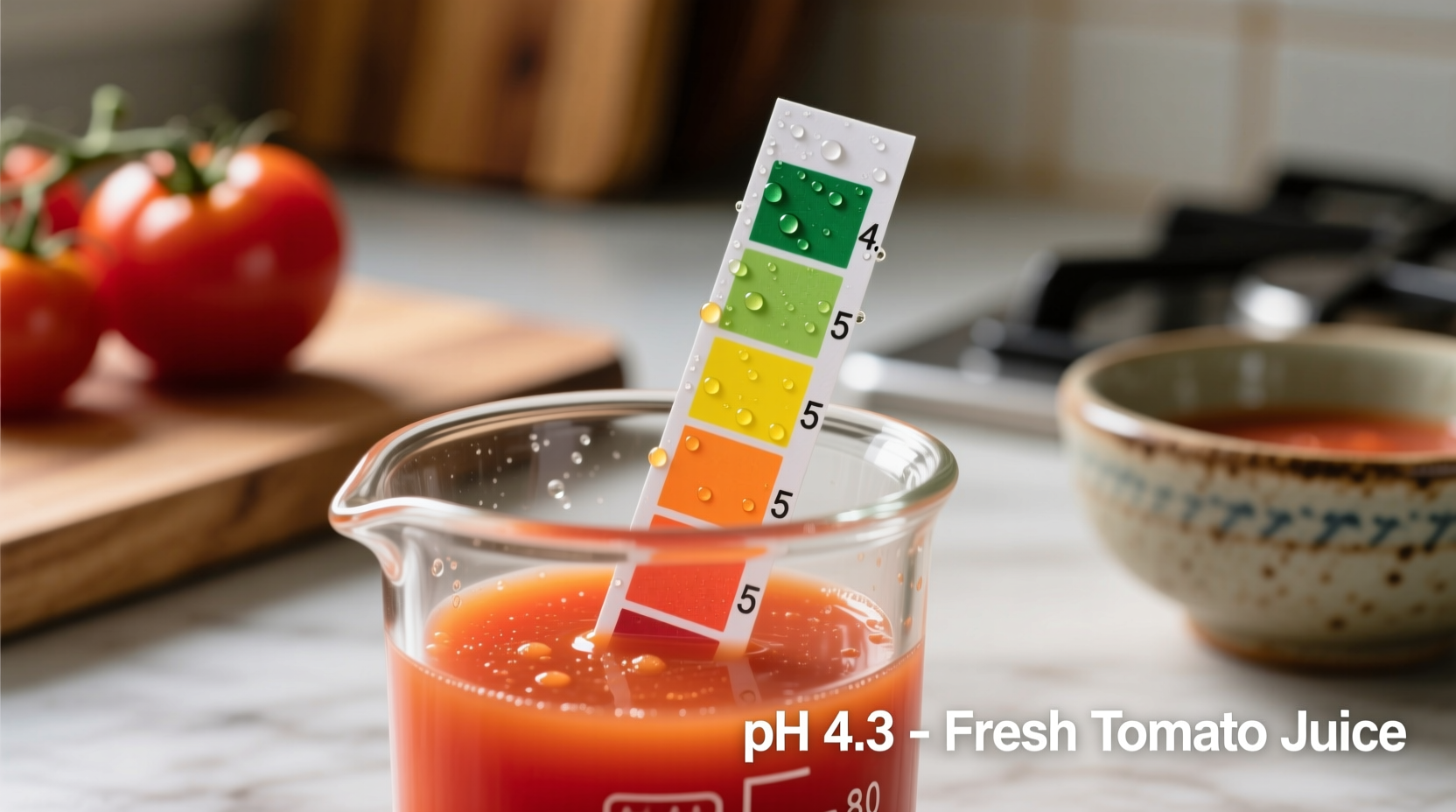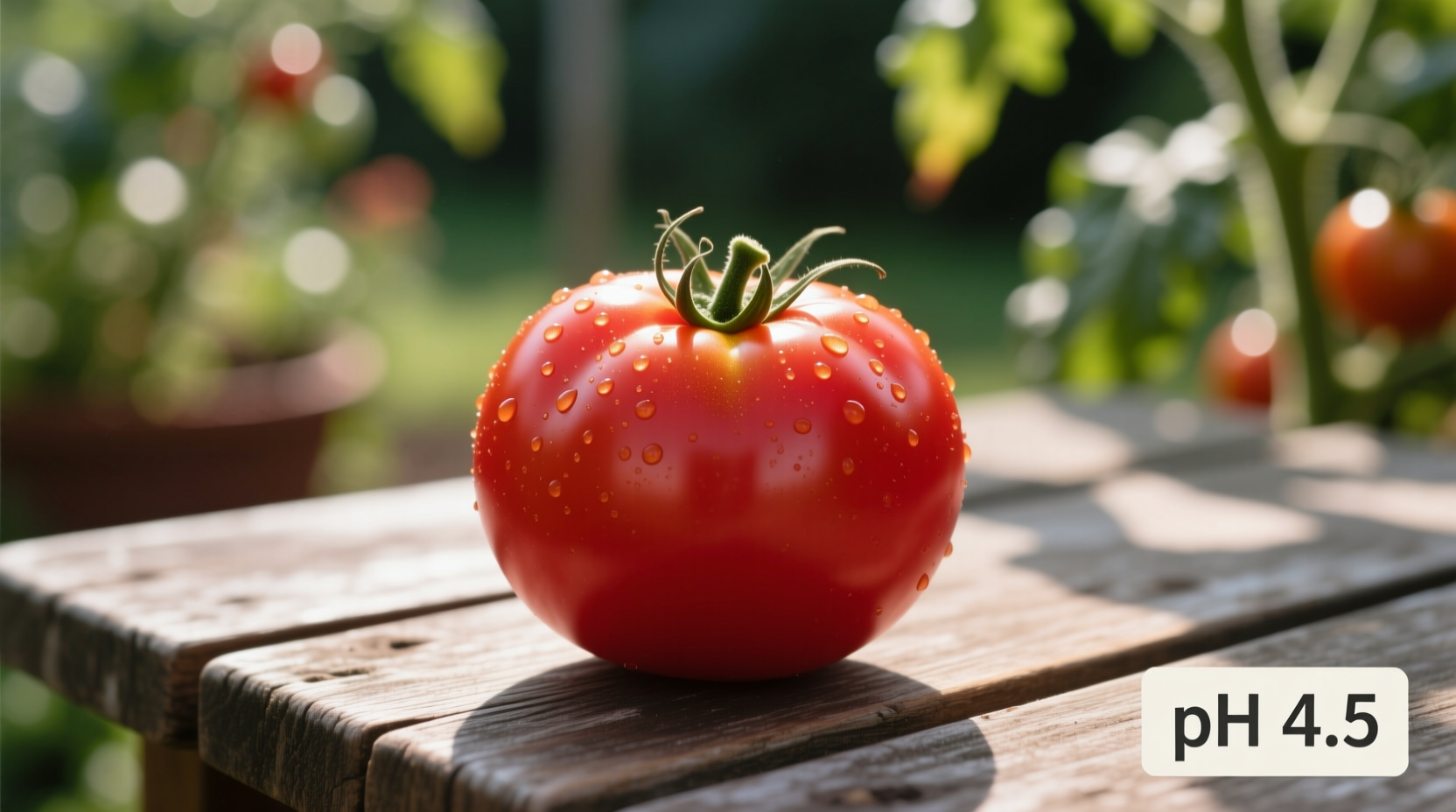When you're preserving tomatoes or trying to understand why they pair so well with certain ingredients, knowing their exact acidity level becomes essential. This guide provides scientifically verified pH values along with practical applications for home cooks, gardeners, and food preservation enthusiasts.
What Exactly Is the pH of a Tomato?
Tomatoes fall within the acidic range of the pH scale, which measures how acidic or alkaline a substance is from 0 (most acidic) to 14 (most alkaline), with 7 being neutral. The typical pH range for fresh tomatoes is 4.3 to 4.9, depending on variety and ripeness.
This acidity level places tomatoes in the "high-acid" food category according to the National Center for Home Food Preservation, which defines high-acid foods as those with a pH of 4.6 or lower. This distinction is critical for safe home canning practices.
| Food Item | Typical pH Range | Acidity Classification |
|---|---|---|
| Tomatoes (fresh) | 4.3-4.9 | High-acid |
| Lemons | 2.0-2.6 | Very high-acid |
| Carrots | 5.88-6.40 | Low-acid |
| Watermelon | 5.18-5.60 | Moderate-acid |
This comparative data from the USDA FoodData Central shows where tomatoes sit relative to other common foods. The table demonstrates why tomatoes are generally safe for water bath canning while vegetables like carrots require pressure canning.
Why Tomato pH Matters in Real Applications
Understanding tomato acidity isn't just academic—it directly impacts several practical scenarios:
Food Preservation Safety
The pH level determines whether you can safely use water bath canning (for high-acid foods) or must use pressure canning (for low-acid foods). Since most tomatoes fall just above the critical 4.6 threshold, many preservation experts recommend adding citric acid or lemon juice when canning tomatoes to ensure safety.
Gardening and Plant Health
Tomato plants thrive in slightly acidic soil (pH 6.2-6.8), but the fruit's internal pH remains consistently acidic regardless of soil conditions. However, soil pH affects nutrient availability—particularly calcium, which helps prevent blossom end rot. When soil pH drops below 5.5, tomatoes may develop calcium deficiencies even when calcium is present in the soil.
Culinary Chemistry
Tomato acidity creates the bright, refreshing quality we associate with fresh tomatoes and forms the foundation of many sauces. This acidity:
- Balances sweetness in dishes
- Helps emulsify vinaigrettes
- Activates pectin in jams and preserves
- Interacts with baking soda in recipes like red velvet cake

Factors That Change Tomato pH Levels
Several variables affect the precise pH measurement of tomatoes:
Ripeness Timeline
As tomatoes ripen, their pH increases (becomes less acidic):
- Green stage: pH around 4.3-4.4 (most acidic)
- Breaker stage (first color): pH around 4.5
- Full red ripe: pH 4.7-4.9 (least acidic)
This ripening timeline, documented by researchers at University of Minnesota Extension, explains why green tomatoes work better for pickling and why fully ripe tomatoes taste sweeter.
Varietal Differences
Different tomato varieties have slightly different pH profiles:
- Cherry tomatoes: Typically more acidic (pH 4.3-4.6)
- Beefsteak varieties: Slightly less acidic (pH 4.6-4.9)
- Yellow/orange tomatoes: Often less acidic than red varieties
Growing Conditions
While soil pH affects plant health, research from Oregon State University Extension shows it has minimal impact on the fruit's internal pH. However, factors like:
- Water availability during growth
- Sun exposure
- Fertilizer composition
- Harvest timing
can cause slight variations in the final pH measurement.
How to Measure Tomato pH Yourself
If you're preserving tomatoes or conducting gardening experiments, here's how to get accurate pH readings:
- Prepare your sample: Blend a representative portion of tomato (including skin and seeds) until smooth
- Filter if necessary: Strain through cheesecloth for pH meter testing (not needed for strips)
- Test immediately: pH can change as the sample oxidizes
- Use proper tools: Calibrated pH meter (more accurate) or high-quality pH strips (range 3.0-6.0)
- Take multiple readings: Test several samples from different parts of the fruit
For home canning purposes, the National Center for Home Food Preservation recommends adding 1 tablespoon of bottled lemon juice or 1/4 teaspoon of citric acid per pint of tomatoes to ensure safe acidity levels, regardless of your measured pH.
Tomato Acidity in Context: When It Really Matters
Understanding the context where tomato pH is critical versus where minor variations don't matter can save you unnecessary worry:
| Scenario | Why pH Matters | Acceptable Range |
|---|---|---|
| Home canning tomatoes | Prevents botulism growth | Must be ≤4.6 |
| Growing tomatoes | Affects nutrient uptake | Soil pH 6.2-6.8 (fruit pH unaffected) |
| Cooking sauces | Flavor balance | 4.3-4.9 (personal preference) |
| Tomato-based cocktails | Balance with spirits | No critical threshold |
This context boundary information helps prioritize when precise pH measurement is essential versus when it's merely interesting information.
Understanding Tomato Acidity Chemistry
The primary acids in tomatoes are:
- Citric acid: 71% of total acidity (provides bright, citrus-like flavor)
- Malic acid: 15% (contributes apple-like tartness)
- Other acids: Ascorbic (vitamin C), oxalic, and succinic acids
This acid composition explains why tomatoes taste different from other acidic fruits like lemons (which are almost entirely citric acid) or apples (higher in malic acid). The specific acid profile contributes significantly to tomatoes' unique flavor characteristics.











 浙公网安备
33010002000092号
浙公网安备
33010002000092号 浙B2-20120091-4
浙B2-20120091-4